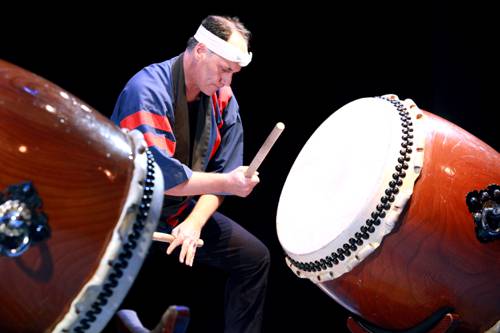
FAQ About The Role of Traditional Japanese Drumming (Taiko) in Modern Music

What is Taiko drumming?
Taiko drumming is a traditional Japanese form of percussion that involves playing a variety of drums, collectively known as taiko, which means 'drum' in Japanese. It is characterized by its dynamic performance style, which combines music, choreography, and various forms of Japanese martial arts.

How has traditional Taiko drumming influenced modern music?
Traditional Taiko drumming has influenced modern music by integrating its powerful rhythms and dynamic performance style into contemporary genres. Artists and composers worldwide have incorporated Taiko elements into classical compositions, film scores, and popular music to add dramatic effects and a sense of cultural depth.

Are there famous bands or artists known for using Taiko in their music?
Yes, several bands and artists have embraced Taiko drumming in their music. Notable examples include Kodo, a renowned professional Taiko drumming troupe from Japan, and international artists such as Mickey Hart from the Grateful Dead, who have incorporated Taiko sounds into their work.

What role does Taiko play in cultural ceremonies in Japan?
In Japan, Taiko drumming plays a significant role in cultural ceremonies, festivals, and rituals. It is often used in traditional Shinto and Buddhist ceremonies to summon spirits, create a spiritual atmosphere, and celebrate seasonal events like harvest festivals (matsuri).

How do Taiko drummers perform?
Taiko drummers perform with a combination of precise rhythmic patterns and choreographed movements drawn from martial arts. Performances are visually captivating, with drummers moving in synchronized formations while playing passionately to amplify both sound and visual impact.

Can Taiko be incorporated into contemporary Western music genres?
Yes, Taiko rhythms and drumming techniques can be incorporated into contemporary Western music genres such as rock, pop, and electronic music. The inclusion of Taiko provides a unique, powerful percussive element that enhances the sound and adds a distinctive cultural influence.

What is the history of Taiko drumming?
The history of Taiko drumming dates back over a thousand years in Japan. It has its roots in traditional Japanese religious ceremonies, military events, and theatrical performances like Noh and Kabuki. Over time, Taiko evolved, becoming a cultural symbol and a popular art form worldwide.

Is there a difference between traditional and modern Taiko drumming?
Yes, traditional Taiko drumming focuses on ceremonial and ritualistic performance styles, adhering to historical forms and techniques. In contrast, modern Taiko drumming often includes blends with other musical styles and emphasizes theatrical elements to appeal to contemporary audiences.

How do global audiences respond to Taiko drumming in concerts?
Global audiences generally react positively to Taiko drumming in concerts, being captivated by its unique sound, high-energy performances, and cultural richness. It often draws curiosity and admiration, leading to appreciative ovations and increased interest in this Japanese art form.

What instruments are typically used in Taiko performances?
Taiko performances typically use a variety of drums, including the large odaiko, the medium-sized chu-daiko, and smaller drums like the shime-daiko. Additional percussion instruments such as cymbals and gongs may be used depending on the performance style.

Are there misconceptions about Taiko drumming's role in modern music?
One misconception is that Taiko drumming is limited to traditional Japanese music only. In reality, it plays a significant role in contemporary global music, contributing its powerful sound and rhythms to a variety of modern compositions across different genres.

How is Taiko drumming used in films and media?
Taiko drumming is often used in films and media to convey intense emotions, enhance dramatic scenes, and introduce cultural authenticity. Its deep, resonant tones and dynamic rhythms are effective for soundtracks, trailers, and cultural documentary scores.

Why is Taiko drumming considered a physical art form?
Taiko drumming is considered a physical art form due to its demanding and energetic performance style. Drummers use their full bodies to execute powerful and synchronized movements, often inspired by martial arts, making it both a musical and physical spectacle.

Who are the world-famous Taiko groups to watch?
Renowned Taiko groups include Kodo, who are known for their skilled performances and international tours, and Yamato, famous for their intense energy and creativity. These groups have played a crucial role in popularizing Taiko outside Japan.

How can one learn to play Taiko drums?
Learning to play Taiko drums typically involves seeking instruction from experienced teachers or joining Taiko drumming workshops and communities. Many regions around the world have Taiko schools or clubs where beginners can learn the basic techniques and participate in performances.

What makes Taiko drumming visually appealing?
The visual appeal of Taiko drumming lies in the powerful and graceful movement of the performers, their vibrant traditional costumes, and the synchronized choreography. These elements together create a striking visual spectacle that complements the auditory experience.

Is Taiko used in fusion music?
Yes, Taiko is frequently used in fusion music, where it merges with different musical styles, including jazz, classical, and electronic genres. This fusion allows unique cross-genre creations that showcase the versatility and universal appeal of Taiko drumming.

What challenges do Taiko drummers face in modern performances?
Taiko drummers in modern performances face challenges such as maintaining the traditional elements while innovating to appeal to contemporary audiences. They must balance historical authenticity with creativity in choreography, composition, and presentation to keep the art form relevant.

Does Taiko drumming have a spiritual aspect?
Yes, Taiko drumming often has a spiritual aspect, especially in traditional contexts such as Shinto and Buddhist ceremonies, where its performance is believed to connect the physical world with spiritual realms. This spiritual dimension can also be present in modern interpretations that draw from these roots.

How has the internet influenced the spread of Taiko drumming?
The internet has significantly influenced the spread of Taiko drumming by providing a platform for performance videos, tutorials, and global networking. It allows enthusiasts to share information, organize virtual workshops, and expose wider audiences to the art form.
